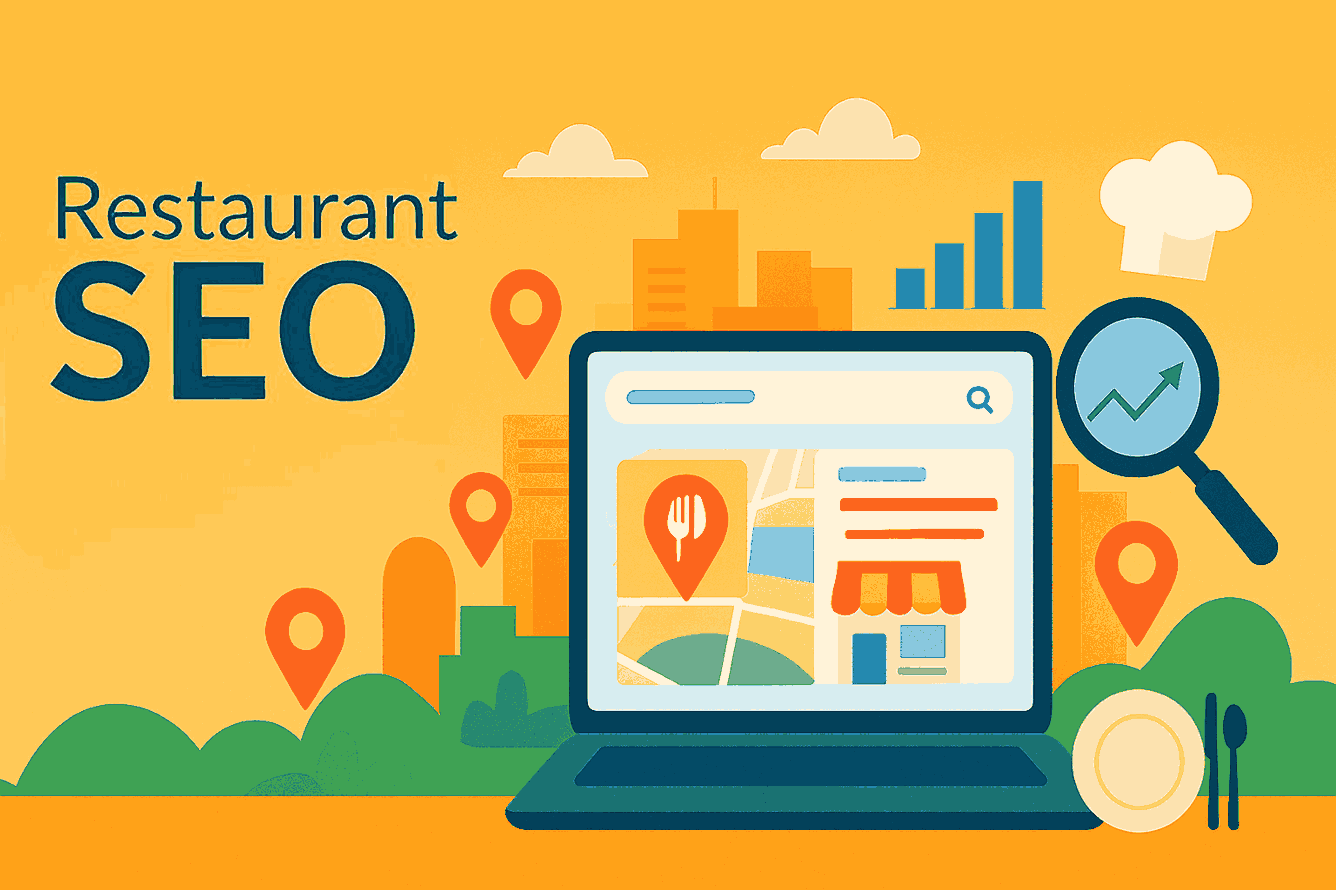Today, most restaurant searches begin online. A 2023 study by Restaurant Technology News shows that 40% of consumers use Google Search to discover new dining options.
If your website is not optimized for these searches, you risk losing customers who are actively looking for restaurants like yours. Strong SEO ensures your restaurant appears in front of these hungry searchers, driving more visitors to your website and ultimately through your doors.
This guide explains everything you need to know about restaurant SEO and the most effective strategies to help your business stand out in local searches.
What Is SEO and Why Should Restaurants Care?
Restaurant SEO (Search Engine Optimization) is the practice of optimizing your website to increase your restaurant’s visibility on search engines like Google. In simple terms, it helps your restaurant show up when hungry customers search for places to eat. Because most people look for dining options within their city, neighborhood, or even a few blocks away, SEO for restaurants is highly local.
Today, most diners search directly from their smartphones while they’re on the go. They want instant access to menus, reviews, or directions. For example, when someone searches for “best pizza near me,” Google displays a list of three nearby restaurants, with their ratings, opening hours, and services. Local SEO focuses on improving your restaurant’s visibility in these high-intent local searches, where customers are ready to order or visit right away.
Top Benefits of Restaurant SEO
SEO for restaurants helps your business show up when potential customers look for services like yours. This translates into many advantages that set the foundation for your brand’s success. Some of its key benefits include:
a. Increased Local Visibility
When people look for restaurants online, they typically write their location name along with what they’re looking to eat. For example, they may look for fast food restaurants near them or “Best Thai food restaurants in Oviedo.” In both searches, Google will show them the top three restaurants that match their intent. These top 3 results are called the local 3-pack. When implemented correctly, SEO ensures your restaurant appears in these three spots, increasing its visibility to potential customers.

b. More Website Traffic and Online Orders
A survey by MGH shows that 69% of customers say the website helps them decide if they would dine in at the restaurant. Meanwhile, 43% visit a website to determine if they wish to place an order from a restaurant. SEO helps your website show up at the top of the search engine results page. Most customers will click on your website’s link to learn about your services and what sets you apart from restaurants that also offer services like yours. If your offers match what they’re looking for, they will consider dining out or placing an order.

c. Higher Foot Traffic
Once people see your restaurant in the local pack, they will click on the name to find more details. This is where they can use the “Directions” feature of Google Maps to find you instantly. This makes it easier for people to visit your business physically, even if they’re not in the immediate vicinity of your site. As a result, SEO not only boosts online traffic to your site but also ensures more people walk through your doors to dine in your restaurant.
d. Better Reputation Management
Online reviews play a major role in how customers choose where to eat. Data from BrightLocal shows that up to 38% consumers consider a minimum average of 4 stars enough to consider using a business. SEO helps highlight positive reviews. It ensures businesses appear prominently in Google’s rich results. As a result, your restaurant appears more credible to future diners, who might be looking to eat at your place.
e. Competitive Advantage
When your restaurant ranks higher in search results, your customers see you before your local competitors. This means you get more traffic than other restaurants operating in your area. Besides this, SEO helps you own niche searches, such as “best vegan brunch in Oviedo” or “gluten-free pizza near me.” These are high-intent searches from people ready to make a decision. Targeting these searches not only brings in more customers but also builds loyalty and positions your restaurant as the authority in your food category.
Key SEO Strategies Restaurants Should Use
The benefits of SEO only matter if you take the right steps to achieve them. While expert SEO services for restaurants can fast-track results, you can also start improving visibility on your own. If you want to succeed, focus on these proven strategies:
a. Local SEO for Restaurants
Local SEO is the practice of helping your restaurant show up in searches related to food or restaurants located in a specific geographic area. Why does it matter? Research shows that 76% of people who search for “near me” visit the business within a day. So, when someone searches “restaurants near me,” local SEO ensures your business appears front and center.
Three key factors can drive success for local SEO:
NAP Consistency
NAP is short for the name, address, and phone number. These are critical details of your business that should be identical across all platforms and directories. Because consistent information tells people that your brand is trustworthy and authentic.
Google Business Profile (GBP) optimization
GBP optimization is a critical SEO strategy for restaurants. GBP is a free tool by Google that helps you control your restaurant’s presence online using Google services such as Search and Maps. After claiming your GBP, optimize it with relevant details of your business. Include a keyword-rich description. Add your menu, photos, videos, business hours, services, and website link. Also, stay in touch — post frequently and track reviews.
Local Citations and Directories
List on trusted sites and directories to boost your credibility and rankings. Local citations are any online mentions of your restaurant’s NAP and website link. These can appear on social media, local blogs, Maps, or business directories. Meanwhile, directories can be restaurant-specific (like TripAdvisor, OpenTable, or Uber Eats) or General directories (Yelp, Yellow Pages, Bing Places, etc.)

b. On-Page Restaurant Website SEO
On-page SEO means optimizing elements directly on your restaurant’s website to rank it higher in search results. This includes your website’s content, links, images, design, and more. To optimize for on-page SEO, consider these factors:
Keyword-Rich Titles and Meta Descriptions
Titles and meta descriptions are the first things people see before visiting your site. SEO keywords for restaurants usually have a local intent. So, you can pair your primary keyword with a local modifier to rank and show relevance. You should also summarize your unique selling points in the meta description with your location and a reason to visit. For example, “Classic Pad Thai, seasonal curries & late-night takeout in Tampa. Book a table or order delivery” has all the elements customers need to click on your website.
Location-based landing pages:
A landing page is a webpage created for a specific goal, like promoting a restaurant location, menu, or offer. It aims to address specific customer needs and provide clear information, along with a call-to-action. Therefore, your landing pages should have content that highlights your unique selling points, reviews, and location-based services.
Mobile-Friendly Design:
People search for restaurants or food on their smartphones. Moreover, Google uses a mobile-first indexing approach. This means that it prefers looking at the mobile version of your website to show it in search results. According to Google, 53% of users leave a mobile site if the loading takes more than 3 seconds. Therefore, your website should not only adapt to smaller screens but also reduce loading times to remain visible online.

c. Content Marketing
Content marketing is one of the critical factors in restaurant SEO. It means creating valuable content, such as blog posts, that attract readers beyond basic searches. For restaurants, this includes sharing their niche-specific insights and putting out guides that resonate with the local community.
A great place to start is blogging about local events. You can create posts like “Top Food Festivals in Orlando This Summer.” You can also highlight food trends like “Why Plant-Based Dishes Are Growing in Orlando.” This shows that you’re in tune with what’s happening in the industry – all while attracting local customers.
d. Schema Markup
Schema markup is code added to your website that helps search engines understand key details about your restaurant and show them in rich results. These can be your menu, review stars, special offers, events, FAQs, or images. Some helpful schemas for restaurants include:
- Restaurant Schema to showcase your business details like NAP, cuisine type, operating hours, etc.
- Menu Schema to display dishes and prices directly in search.
- Hours Schema to show accurate opening times.
- Reviews Schema to highlight star ratings.
e. Reputation & Review Management
A latest study by PYMNTS shows that 46% of consumers are more likely to order from a restaurant after reading a positive review. Needless to say, reviews can significantly impact your business’s reputation and sales. But it can also affect your rankings. This is because Google algorithms look at reviews as signals of credibility and authority. Therefore, encourage customers to leave reviews and frequently respond to them. This will help you build trust. At the same time, you improve your visibility and attract more customers.
4 Common Mistakes Restaurants Make with SEO
SEO marketing for restaurants is incredibly competitive. Even small errors can seriously hurt your online rankings and niche authority. If you’re taking your business’s SEO strategies into your hands, avoid these common errors.
1. Ignoring Google Business Profile
If you do not update your Google Business Profile frequently, it can confuse customers with incorrect opening hours, an outdated menu, or inconsistent NAP details. These errors can seriously reduce customers’ trust and damage your local rankings. Therefore, review and update your profile regularly.
2. Skipping Location-Based Keywords
Without local keywords, your restaurant will miss both online and foot traffic. So, make sure to use local terms like city names, neighborhoods, or landmarks in titles, descriptions, and page content. In addition, your content should target customer search phrases to align with local intent and be more visible.
3. Neglecting Google Posts
A profile without posts looks inactive. It indicates a lack of professionalism and enthusiasm for your own services. As a result, few people will click or engage with your profile. Google also rewards active profiles. So posting updates about promotions, events, or specials improves both visibility and customer interaction.
4. Not Tracking SEO Performance
Without tracking your website metrics, it’s impossible to see if you’re doing anything right. Tools like Google Analytics, Search Console, or SEMrush highlight what’s working and what isn’t. Tracking these metrics helps you identify marketing gaps and make smarter decisions.
Restaurant SEO Success Story: Blue Agave
To understand how powerful SEO can be for restaurants, let’s look at the story of Blue Agave, a well-known Mexican restaurant located in Houston. They were facing two major challenges: intense local competition and low online visibility.
But their challenges ran deeper. Their restaurant’s information was inconsistent across platforms. Website content was thin and unengaging. In addition, their local search rankings were weak, so potential customers had a difficult time finding them.
PNC Logos stepped in to solve these issues. Here’s how our team of SEO experts addressed these challenges:
- We gave their website a complete refresh to improve the user experience.
- We also launched a blog to keep their content fresh and relevant.
- Using competitor insights, we fine-tuned their overall strategy.
- On the SEO front, we restructured the site, optimized keywords and CTAs, and strengthened internal linking.
- For local search, we focused on strategic anchor link-building and a fully optimized Google Business Profile.
The results were striking. In just six months, Blue Agave saw an 80% increase in users. They reached 71 organic goals and boosted Google My Business interactions by 26.6%. With these improvements, the restaurant gained more credibility, attracted higher foot traffic, and secured a stronger position in Houston’s dining scene.
Final Words
Restaurant SEO helps you appear where customers are searching, driving more website visits and foot traffic to your business. To optimize for these searches, you need to implement both local, on-site, and content marketing strategies. At PNC Logos, we help restaurants like yours stand out in high-intent local searches. Our team handles everything, from optimizing your Google Business Profile to improving your website’s technical performance. If you want to drive more hungry customers to your doors, contact us today to get started!





